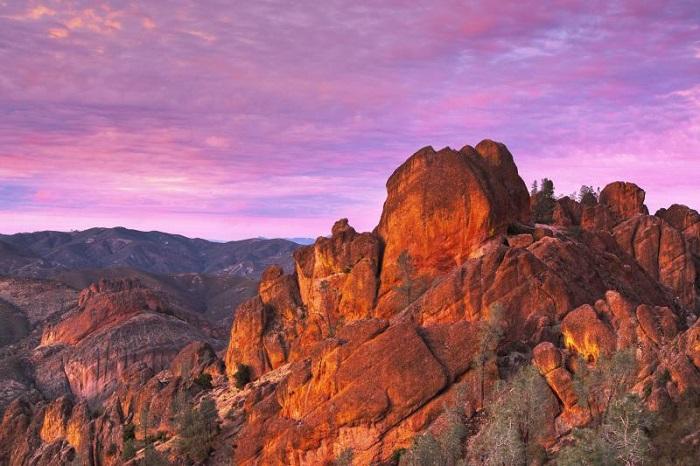
Entrance to Pinnacles National Park would go from $15 to $25 under a proposed increase/NPS
With National Park Service sites aiming to standardize entrance rates across the country in 2018, another wave of proposed fee increases is now open for public comment.
At Pinnacles National Park in California, the cost for vehicle entry would go up 67 percent, from $15 to $25, and the park’s annual pass would double from $25 to $50. Motorcyclists, hikers, and bikers would also see their rates increase.
According to the park, additional revenue generated would fund projects such as the rehabilitation of the Bear Valley School, the construction of vault toilets to replace portable facilities, and the building of a new entrance station in the east side of the park.
At Glacier National Park in Montana, officials are seeking a modest increase by comparison. The park, which drew nearly 3 million visitors last year, proposes raising the cost of its annual pass from $50 to $60.
“The funds raised through entrance fees including passes are critical to improve facilities and infrastructure, and to provide an enhanced level of visitor service,” said Park Superintendent Jeff Mow.
Park entrance and campground fees have supported a number of projects in Glacier, including a portion of the Many Glacier Hotel restoration, new interpretive exhibits at visitor centers, trail repairs, and winter snowshoe walks.
Back in California, Cabrillo National Monument proposes raising entry for vehicles from $10 to $15, for hikers and bikers from $5 to $7, and for motorcyclists from $7 to $10. In addition, the park’s annual pass would jump to $30 from $20. This would be only the second entrance fee increase in 31 years at Cabrillo.
The park says it plans to use the additional fees for installation of 38 new wayside exhibits, repair of the damaged Bayside Trail, production of a new signature film for Cabrillo, improved accessibility to park structures and resources, and an upgrade of informational displays for the World War I and World War II bunkers.
This fee proposals and civic engagement process are part of a review of the Federal Land Recreation Enhancement Act at parks nationwide. Following the public comment period, feedback will determine how, or if, a fee increase will be implemented.
To comment
Pinnacles National Park
- Deadline: September 28, 2017
- Online: http://parkplanning.nps.gov/pinn
- Mail: Superintendent; Pinnacles National Park; Attn: Proposed Fee Increase; 5000 Highway 146; Paicines, CA 95043
Glacier National Park
- Deadline: September 30, 2017
- Online: http://parkplanning.nps.gov/GNP_fee_proposal_2017
- Mail: Glacier National Park; Attention: Glacier National Park Annual Pass Fee Increase; P.O. Box 128; West Glacier, MT 59936
Cabrillo National Monument
- Deadline: September 30, 2017
- Online: https://parkplanning.nps.gov/cabr
- Mail: Park Superintendent; 1800 Cabrillo Memorial Drive; San Diego, CA 92106



Comments
Some Americans continue to loudly demand more and more services and infrastructure while simultaneously crying for less taxation and lower fees.
Can anyone explain just how that is supposed to work?
It works like a library does, Lee. You pay for it with taxes. You don't have to pay again when you check out a book. Nor should you. I don't want any special services. If someone needs a sewer hook up, then no one says they shouldn't have to pay. But your analogy is like paying the president extra every time he insults someone.
I see your point, Smoky, but I'm afraid that's too simplistic. I just checked and discovered that nearly $40 of my annual property taxes go to our local library system. But less than $2 of my federal taxes go to our national parks. Congress has chosen to spend our tax money on other things --- like $400,000 pilot's helmets for F35 pilots --- instead of our parks.
The point I'm trying to make is that Americans seem to expect -- even demand -- more from our government while denying any responsibility to pay for what we want. Is that realistic?
In the end, though, someone is gonna have to pay. Or do without. Or put it on the national credit card again.
The land is free.
The Park Rangers, roads, programs, visitor facilities, clean up, rescues, etc. are not. All in all, a great bargain.
PS Buy an annual pass.
I am not opposed to raising fees provided they are in line with inflation or needed due to some extraordinary circumstance. It does feel like many of the increases are far beyond the rate of inflation. It would serve the Park service well to put some perspective behind the increase requests (like in the Carrillo example only with more detail). I.E. the fee hasn't increased since 19xx when it was only xx. Then of course there is the problem of vision and what the money will be used for. Is it to build more roads, parking lots and visitor centers so as to attract the greatest number of people possible? Or is it to address the maintenance backlog? I understand the argument for charging foreign visitors more since they are not paying taxes here but I'd rather see one flat fee for everyone. I am fortunate enough that paying a few dollars more is not a big issue for me but it feels very welcoming to be charged the same as a local resident, be it of a county, state or country, as opposed to being made to feel slightly unwelcome when you are charged more. I was curious as to the history of fees in the parks and came across this which some of you may find interesting. https://www.nps.gov/parkhistory/online_books/mackintosh3/fees1.htm
The parks area bargain at twice the price. why shouldn't someone that uses them pay more than someone that doesn't. I'm in agreement with Lee. ( is that a pig that just flew by?)
By the way, except for the smoke, now is the time to be in Yosemite. No crowds, no traffic.